Spotlight on Dr. Benard Ssebide: Gorilla Doctors New Head Field Vet in Uganda
By Gorilla Doctors Staff on Friday, November 7th, 2014 in Blog.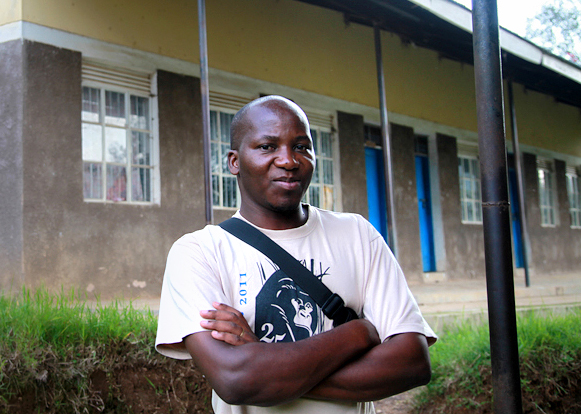
Dr. Benard Ssebide, Gorilla Doctors Head Uganda Field Vet and PREDICT Country Coordinator.
With a mother who was a nurse and a father who was a Medical Officer, there was little doubt as he was growing up that Benard Ssebide would one day end up in medicine. After years of study at Makerere University in Kampala, Uganda, Dr. Benard completed his Doctor of Veterinary Medicine degree. It was in his 3rd year at Makerere, during his clinical training, that Benard met Dr. John Bosco Nizeyi, who currently serves as Gorilla Doctors Capacity Development Coordinator. “Dr. JBN” as he’s known to the Gorilla Doctors staff, was teaching a course on wildlife medicine.
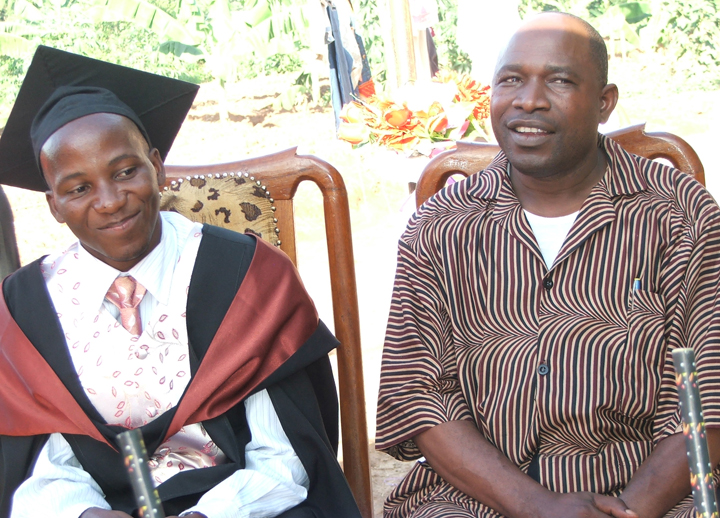
Dr. Benard and Dr. JBN, on Benard’s graduation day from Makerere University.
“I read about Gorilla Doctors when I was still in med school. I knew what they were doing and I took a project for my dissertation in Bwindi Impenetrable National Park, where Gorilla Doctors works,” said Dr. Benard. His Masters project contributed to the development of the IMPACT system, which allows Gorilla Doctors and park rangers to record observations in a long-term database to keep track of the health histories of all monitored mountain and Grauer’s gorillas in the region.
After completing this project and graduating from veterinary school, Dr. Benard began his work as a veterinarian with the Uganda Wildlife Authority (UWA), working with many different wildlife species.
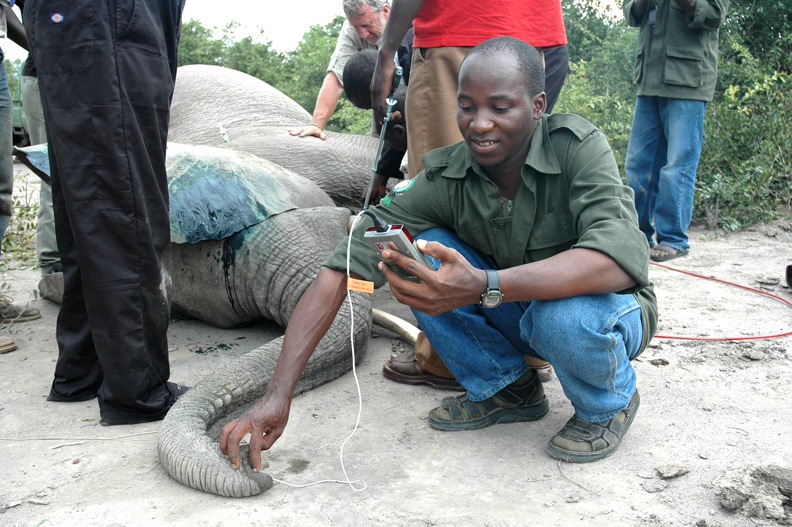
While with the UWA, Dr. Benard worked on a project to track elephant movement along wildlife corridors in the Queen Elizabeth Conservation Area.
With years of hard work, Dr. Benard eventually became the warden in charge of Mgahinga Gorilla National Park and then Chief Park Warden of Bwindi Impenetrable National Park. But his heart was in field work, so in 2007, Dr. Benard joined Gorilla Doctors as a Field Veterinarian and then worked on the PREDICT project to look for emerging pandemic threats in the region. He was recently promoted to Uganda Head Field Veterinarian and PREDICT Country Coordinator.
The Gorilla Doctors PREDICT teams carefully monitor the wildlife populations for highly infectious diseases, such as Ebola and yellow fever. “We are really looking at emerging diseases that can transfer between wildlife to people” said Dr. Benard. The work he and his PREDICT team do include travelling to outbreak sites to collect samples from domestic & wild animals to determine if infectious diseases could be circulating within these populations.
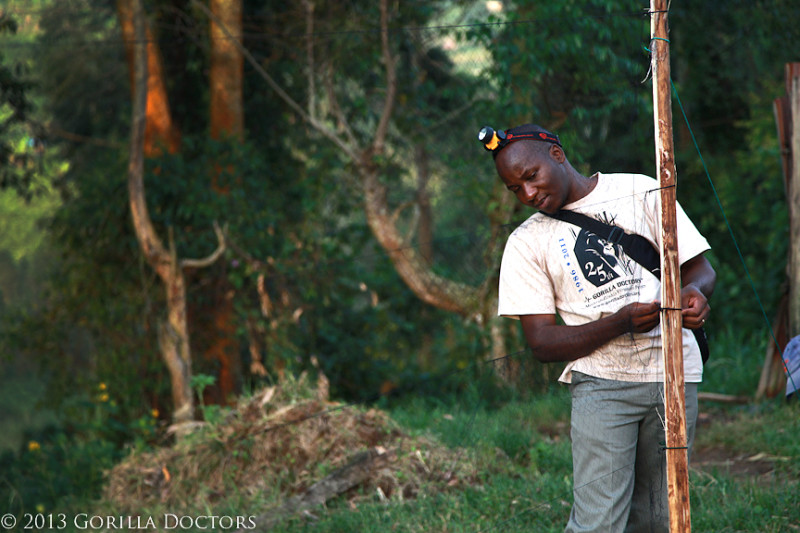
Dr. Benard sets up a mist net near a school on the border of Bwindi Impenetrable National Park to trap fruit bats for testing.
Dr. Benard explains the exciting part of working on the PREDICT project: “the opportunity to learn more. With Mountain Gorilla Veterinary Project, we had the focus on gorillas obviously, but with PREDICT we can look at other species. We know what’s happening in the gorillas. But what about other primates and wildlife species within the gorilla habitat?” Dr. Benard says it’s imperative to study these other species and the infectious diseases found in their populations. “The gorillas are the backbone of tourism here. We have the opportunity to do more research and look at the bigger picture, which will ultimately help to safeguard the health of the gorilla population. With PREDICT, looking at the big picture is the objective, that’s the name of the game.”
The threats to mountain gorillas are great. With only 880 left in existence it is essential that Gorilla Doctors monitors the health and safety of every habituated gorilla group in DRC, Uganda, & Rwanda. “Too much work needs to be done in too small a time for just one veterinarian to do… the Gorilla Doctors work is truly a team effort” said Dr. Benard. “The snare problem, traps set by poachers… it’s just constant.” As well, Dr. Benard points out that, “as communities and countries evolve, so do the diseases that affect eastern gorillas.”
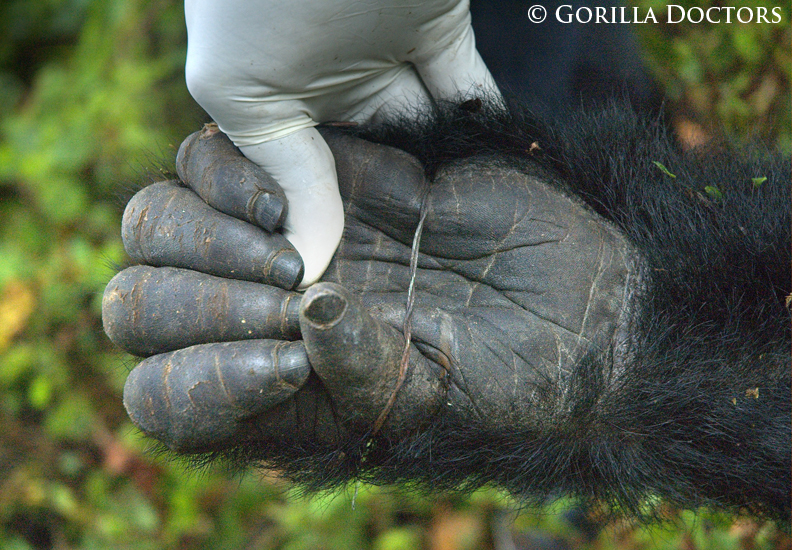
Dr. Benard intervenes to free a mountain gorilla caught in a wire snare in Bwindi Impenetrable National Park, Uganda.
“These days, we are seeing new things. More symptoms are showing up, there are more samples to collect, there is more research to be done.” Dr. Benard recalls a Scabies outbreak in 2001 in Bwindi’s Nkuringo group. The group was frequently venturing outside the park boundaries, near the local communities where it is suspected that the group members picked up the disease from domestic animals. “Scabies is more serious in gorillas than it is in humans. Some animals had complete hair loss.” Eventually Dr. Benard, in his interventions, was able to dart each group member with long acting medication to bring them back to good health.
With tourism helping to boost efforts to conserve eastern gorillas, the mountain gorilla is a success story in the conservation world. But, there remains much work to be done and many needs to be met to continue that work. “[Gorilla Doctors] relies on private donations to continue our daily operations and we have a lot of needs in terms of supplies, equipment, materials, books, gear” said Dr. Benard. “The terrain here is challenging, the weather here is challenging. We need good cameras to take high quality photos & recordings. We need post-mortem materials to take samples and expand our knowledge on disease and mortality.” Those who donate through the Gorilla Doctors website are making a huge difference to make sure that this important work can continue and every single eastern gorilla suffering from a life-threatening illness or injury can receive the veterinary treatment they need.


 Donate
Donate